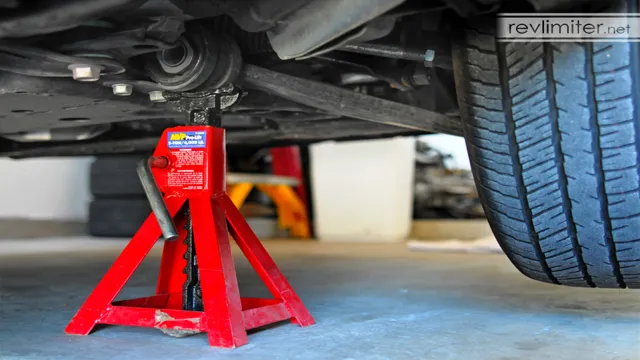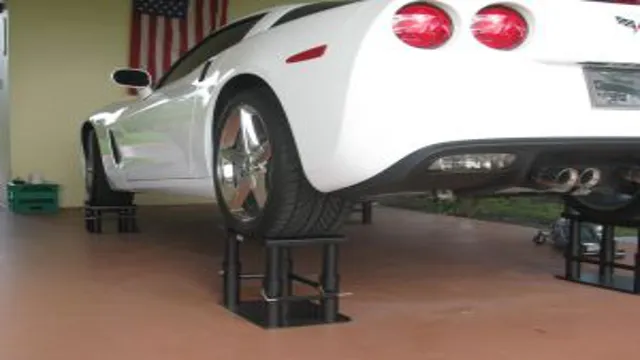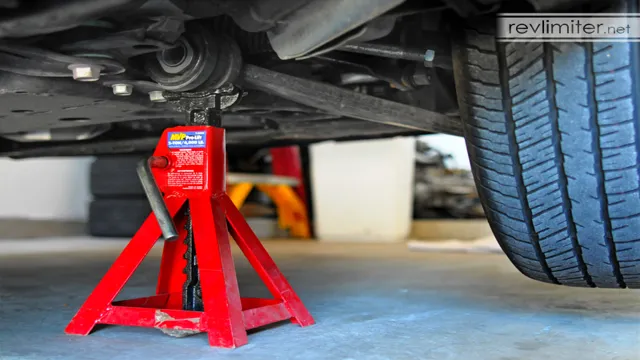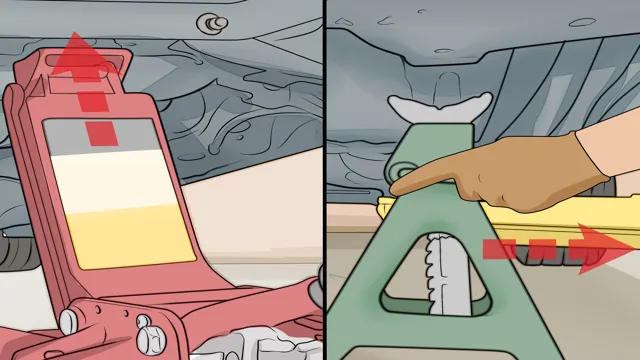How to Use Jack Stands to Change Oil: A Step-by-Step Guide for Safe and Easy Oil Change
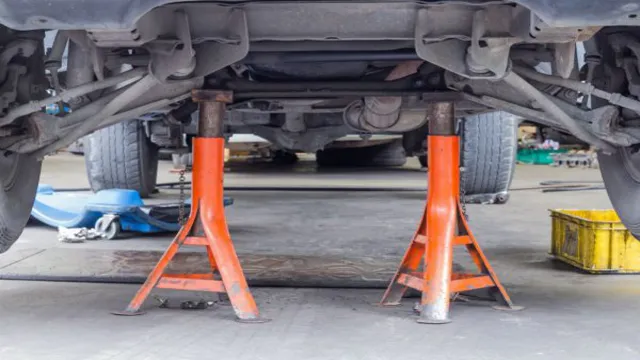
Thinking about getting under that car for an oil change? Before you jump right in, make sure you’re aware of the potential dangers. That’s where jack stands come in. These trusty pieces of equipment help keep you safe and secure while you’re working on your vehicle.
With the right setup, you can get the job done quickly, efficiently, and above all else, safely. So, how do you go about using jack stands for an oil change? In this blog post, we’ll walk you through the steps so you can feel confident and informed. Whether you’re a seasoned mechanic or a newbie DIYer, this guide is for you!
Why Use Jack Stands
If you’re planning to change your vehicle’s oil, using jack stands is highly recommended for your own safety. Jack stands help to keep your car in a stable and elevated position while you work underneath it. To start, make sure that you park your car on a flat and level surface and engage the parking brake.
Then, use a jack to lift one side of the car and place the jack stand under the vehicle’s jacking point. Be sure to select a jacking point that can safely support the weight of your vehicle. Repeat the process on the other side of the car.
Remember to never work under a car supported only by a jack. Always secure it with at least two jack stands. With your vehicle lifted and secured, you can safely change the oil and carry out other maintenance tasks without having to worry about your safety.
So the next time you plan to change your car’s oil, remember to use jack stands to make your job easier and safer.
Prevent damage to car and injury to self
Why Use Jack Stands? It’s a common mistake to solely rely on a car jack when performing automotive repairs. However, using jack stands is crucial in preventing damage to your car and avoiding injury to yourself. A car jack is only meant to lift the vehicle off the ground, and it’s not stable enough to keep it in place for an extended period.
Jack stands, on the other hand, are designed to support the weight of a car and provide stability during repairs or maintenance. Without them, a car can easily fall off the jack if it’s bumped or if the jack fails. That could result in serious damage to the car and potentially serious injury to yourself.
It’s essential to make sure your vehicle is safely supported on jack stands before starting any work. By doing so, you can avoid accidents and ensure that the repairs are done correctly. Don’t take any chances; invest in a set of jack stands to provide the necessary support and stability for your vehicle when working on it.
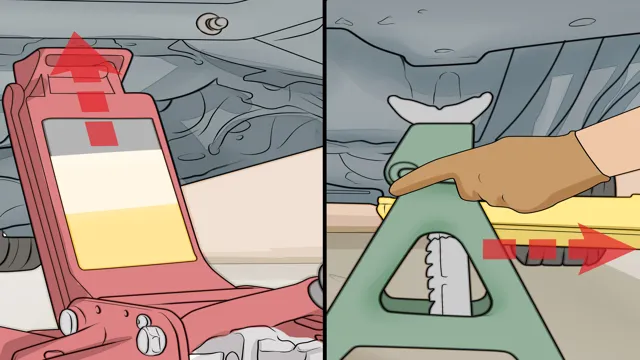
Choosing the Right Jack Stands
If you want to change your car’s oil, using jack stands is a safe and effective way to get the job done. However, it’s crucial to choose the right jack stands for your vehicle’s weight and height. The weight rating should match or exceed your car’s gross weight, and the height of the stands should be appropriate for the clearance level of your car.
It’s also important to make sure the stands are sturdy and stable, with a wide base and a locking mechanism to prevent any accidental collapses. When using jack stands, it’s best to follow the manufacturer’s instructions carefully, making sure to place them on a level surface and position them correctly under the vehicle. Remember, safety should always come first when working underneath a car, so take your time and don’t rush the job.
By choosing the right jack stands and using them properly, you can change your car’s oil with confidence and peace of mind.
Weight rating and height adjustment
Choosing the right jack stands can be a daunting task, but two crucial factors to consider are weight rating and height adjustment. The weight rating indicates how much weight the stand can support safely. It’s important to choose a jack stand with a weight rating that’s higher than your vehicle’s weight.
On the other hand, height adjustment refers to the jack stand’s ability to accommodate different heights. Some jack stands have a fixed height, while others have adjustable height settings. When choosing a jack stand, it’s essential to ensure that its height range matches your needs.
Remember, selecting a jack stand with a weight rating and height adjustment that doesn’t meet your requirements can lead to disastrous consequences. So always be careful and do your research before choosing a jack stand for your vehicle.
Preparing the Car for Oil Change
Before changing the oil in your car, it is important to properly prepare the vehicle. To begin, you will need to gather all the necessary tools and materials, such as a jack stand, oil filter wrench, and oil pan. Once you have everything you need, park the car on a level surface and turn off the engine.
Then, engage the parking brake and place blocks behind the rear wheels to prevent the car from rolling. Next, locate the jack points on the car, which can be found in the owner’s manual. Use the jack stand to lift the car and secure it in place, making sure it is stable before crawling underneath.
Remember to never rely solely on a jack to support the car, as it can be dangerous. Once the car is properly elevated, you can begin the oil changing process using the recommended steps provided by the manufacturer. By following these steps, and utilizing the jack stand, you can safely and efficiently change the oil in your car without any problems.
Park car on level surface and engage emergency brake
When it comes to changing your car’s oil, it’s important to start by preparing your vehicle to ensure a smooth and effective oil change. Begin by parking your car on a level surface and engaging the emergency brake, this will prevent your car from rolling or shifting during the oil change process. This step ensures your safety as well as the safety of your vehicle.
It’s important to make sure your car is stationary before proceeding with the oil change. A sloping surface can create difficulties with draining the old oil and adding fresh oil to the engine. Additionally, having a level surface helps ensure that the oil drains completely and accurately, giving you a clear picture of how much oil is being drained, and how much is added back in.
Ensuring that your vehicle is level is the crucial first step in preparing your car for an oil change. Remember to take your time, be safe, and gather all the necessary supplies before proceeding with the oil change.
Locate and secure proper jacking points
Locating and securing proper jacking points is an essential part of preparing your car for an oil change. It’s important to find the right spots on your car frame so that you can safely lift it without causing any damage. Once you’ve located the manufacturer’s recommended jacking points, you will need to make sure that they are clear of any dirt or debris.
This will help to prevent any slips or accidents when you begin the oil change process. Once the area is clear, you can then use jack stands to secure the vehicle. These stands will help keep the car stable and reduce the risk of it falling while you work underneath it.
With these safety precautions in place, you’ll be ready to get down to business and change your car’s oil with confidence.
Setting Up Jack Stands
If you’re looking to change your own oil, you’ll need to know how to use jack stands to keep your car stable and secure while you work. Before you start, make sure you have the right size jack stands for your vehicle’s weight capacity. To begin, park on a level surface and engage your emergency brake.
Then, lift your car with a hydraulic jack until it’s high enough for the jack stands to fit underneath the designated areas listed in your owner’s manual. Slowly lower the car onto the jack stands and give the car a gentle push to ensure it’s stable. Once you’re ready to lower your car, use your hydraulic jack to lift the car slightly off the jack stands, remove the stands one at a time, and slowly lower the car back onto the ground.
Always prioritize safety by following instructions carefully, and if you’re ever unsure, seek professional assistance.
Place jack stands on flat surface
When setting up jack stands, it’s important to place them on a flat surface. This ensures that they provide stable and secure support for your vehicle. If they’re not on a flat surface, they may not be able to support the weight of your car, which can be dangerous.
The last thing you want is for your car to fall off the jack stands and potentially cause serious injury or damage. So, take the time to look for a suitable flat surface before placing your jack stands. Ideally, this surface should be concrete or a similarly firm material.
Once you have found a suitable spot, place the jack stands on the ground and make sure they’re securely in place. By taking these simple precautions, you can keep your vehicle safe and ensure that your jack stands provide the support you need.
Position jack stands under jacking points
Setting up jack stands is an essential part of any car maintenance project. Before getting started, it’s important to choose the right pair of jack stands for the job. Once you have the right equipment, the next step is to position the jack stands properly.
Look for the manufacturer’s recommended lifting points on your car, as well as the jacking points. These are typically located along the underside of the car’s frame. Position the jack stands just outside of these points, making sure that they are level and securely placed.
It’s also essential to check that the jack stands are rated for the weight of your car to prevent accidents. With the right preparation and attention to detail, setting up jack stands can be a simple and safe process.
Lowering the Car onto Jack Stands
When changing the oil in your car, it’s important to ensure that it is safely supported on jack stands. Start by finding a level surface to park your car on and chock the wheels. Position the jack stands under the designated lift points, typically located on the frame or marked on the underside of the car.
Once the stands are in position, slowly lower the car onto them and make sure they are secure and level. Give the car a gentle push to check for any wobbling or instability. When lifting the car up again, be sure to use the same lifting points and remove the stands carefully.
By using jack stands to change your oil, you can ensure that your car is safely and securely supported, preventing potential accidents or damage to your vehicle. Remember, it’s always better to err on the side of caution and take your time when using jack stands to give your vehicle the proper care it deserves.
Slowly lower car onto jack stands
When you’re working on your car, one of the most important steps is safely raising it up onto jack stands. Before beginning, ensure that your car is parked on level ground, with the engine turned off and the emergency brake on. Then, locate the designated jacking points under the vehicle, which can usually be found in the owner’s manual.
Once you’ve found them, slide the jack under the car and pump the handle to lift the vehicle up. When it’s high enough, place the jack stands in a secure position, making sure that they’re aligned with the jacking points. Slowly lower the car onto the stands by carefully releasing the jack’s handle, ensuring that the car is resting securely before proceeding.
Remember, taking the time to properly raise your car onto jack stands can prevent accidents and keep you safe while working on your vehicle.
Ensure car is stable on jack stands
When it comes to working on your car, it’s important to ensure that it’s stable and secure on jack stands before getting started. Before lowering your car onto the jack stands, make sure that you’ve chosen a level and flat surface to work on. Then, locate the jack points on your vehicle and carefully position the jack under these points.
Begin lifting the car up slowly, making sure that it’s remaining level on the jack. Once the car is high enough, you can place the jack stands under the designated lift points and slowly lower the car onto them. Make sure that the stands are securely in place before removing the jack and getting to work.
Double check that your car is stable on the jack stands by giving it a gentle shake or push before getting started. By taking the time to properly lower your car onto the jack stands, you’ll ensure your safety and the stability of your vehicle while you work on it.
Performing Oil Change
Changing your car’s oil is a vital part of vehicle maintenance, and learning how to do it yourself can save you time and money. One important step in the process is using jack stands to elevate the car and allow for easier access to the oil pan. First, find a level surface to park the car and engage the emergency brake.
Locate the jacking points on either side of the car and use the jack to lift each side until the wheels are off the ground. Place jack stands securely under each jacking point before lowering the car onto them. It’s crucial to use jack stands rather than relying solely on the jack to keep the car elevated, as this can cause the car to shift or even fall.
Once the car is secured on the jack stands, you can safely begin changing the oil. Remember to follow the manufacturer’s instructions for the correct type and amount of oil, and dispose of the old oil properly. By utilizing jack stands in your oil change routine, you can ensure safety and efficiency in your vehicle maintenance.
Follow manufacturer’s guidelines for oil change
Performing an oil change is a crucial part of maintaining your vehicle and ensuring its longevity. It is essential to follow the manufacturer’s guidelines on when to change the oil and the type of oil recommended for your car. Over time, oil breaks down and becomes less effective in lubricating and protecting your engine.
If you don’t change the oil in your car, dirt and debris can build up and cause severe engine damage. It is recommended to change the oil every three to five thousand miles to keep your engine running smoothly. By following the manufacturer’s guidelines and getting your oil changed regularly, you can keep your car running efficiently and avoid costly repairs down the line.
Remember, preventive maintenance is key to extending the life of your vehicle.
Always use proper safety precautions
Performing an oil change is an essential part of car maintenance, and it’s important to always use proper safety precautions. First, make sure your vehicle is on level ground and the engine is cool. Then, use a jack and stands to lift your car off the ground safely.
Next, locate the oil pan and remove the drain plug to allow the oil to drain into a container. Once the oil has stopped flowing, replace the drain plug and remove the oil filter. Put a small amount of new oil on the rubber seal of your new oil filter and then install the new filter.
Finally, refill your engine with the recommended amount of fresh oil, start the engine, and check for leaks. Using the right safety measures will ensure a stress-free oil change that keeps you and your vehicle safe on the road.
Removing Jack Stands
Using jack stands to change oil can be a great way to save money and learn some basic car maintenance skills. But once you’ve finished changing the oil, it’s important to remove the jack stands safely. Firstly, you’ll need to slide the jack under the car again and raise the car until the weight is fully supported by the jack.
Once you’ve done this, carefully remove each jack stand in turn, starting with the back ones and then moving to the front. You may need to wriggle them slightly to remove them, but be gentle to avoid jolting the car off the jack. After you’ve taken off each stand, make sure that you don’t leave any pieces behind, and that the area is free of anything that could get caught in the wheels.
Once you’re sure everything is safe, gently lower the car back onto the ground and check that it’s sitting level. Congratulations, you’ve successfully changed your car’s oil with jack stands!
Slowly lift car off jack stands
Removing Jack Stands Now that you’ve successfully changed your car’s oil or rotated the tires, it’s time to remove those jack stands. Slowly lifting the car off the stands can seem like a daunting task, but with the right technique, it’s an easy job. First, make sure the car is in neutral and the emergency brake is on.
Then, locate the jack points on your vehicle before lowering the car back onto the ground with a hydraulic jack. Once the car touches the ground, use a lug wrench to tighten the lug nuts onto the wheel. Double-check that all wheels are secure before taking the car for a test drive.
Remember, safety should always be a priority when working on a vehicle. Don’t rush the process and always take caution with every step. By following these simple steps, you’re ensuring a safe and successful job.
Remove jack stands and store properly
Removing jack stands is a crucial step in ensuring your safety after finishing repairs or maintenance on your vehicle. To remove the stands, first, make sure the car is stable on the ground by lowering it from the jack. Next, loosen the stand’s locking mechanism and remove it from under the car.
Take care not to let the stand drop suddenly or to get your fingers trapped during this process. After releasing all the stands, test the car’s stability by gently pushing it. If it is secure, move the stands to a designated storage area.
Avoid stacking the stands or keeping them in damp areas as they may rust and deteriorate over time. Properly storing your jack stands ensures they will be ready to use for your next project. Remember, investing in quality jack stands pays off in the long run by providing a secure and stable platform for working on your vehicle.
Conclusion
After following these steps, you’ll be a jack stand master, with a newfound appreciation for the security and stability they provide. So next time you need an oil change, don’t settle for anything less than the best – set up your jack stands and hit the streets with confidence. And if anyone asks you how you did it, just tell them you lifted your ride with a little help from your friends: Jack and Stand.
“
FAQs
What are jack stands and why are they important for changing oil?
Jack stands are support devices that help hold a vehicle up while it is being worked on. They are important for changing oil because they provide a stable base for the vehicle and prevent it from moving or tilting.
How do I choose the right type of jack stands for my car?
The right type of jack stands for your car depends on the weight and size of your vehicle. Check your owner’s manual for the recommended weight capacity and choose jack stands that meet or exceed that capacity.
How do I properly jack up my car and place the jack stands?
Place the jack under a sturdy and secure part of your car, such as the frame, and lift it until the wheels are off the ground. Then, place the jack stands under the recommended support points and lower the car onto the stands.
Can I use just one jack stand to change my oil?
It is not recommended to use just one jack stand, as it does not provide enough stability for the vehicle. Always use at least two jack stands to ensure a secure base.
How long can I leave my car on jack stands?
It is not recommended to leave your car on jack stands for an extended period of time. Once the work is complete, lower the car onto the ground and remove the stands as soon as possible.
What are some safety tips to keep in mind when using jack stands?
Always use jack stands on a level and solid surface, never work under a car supported only by a jack, and wear protective gear such as gloves and eye protection.
Can I use jack stands for other repairs besides changing oil?
Yes, jack stands can be used for any repair work that requires a car to be lifted off the ground, such as wheel changes, brake work, and suspension repairs.


